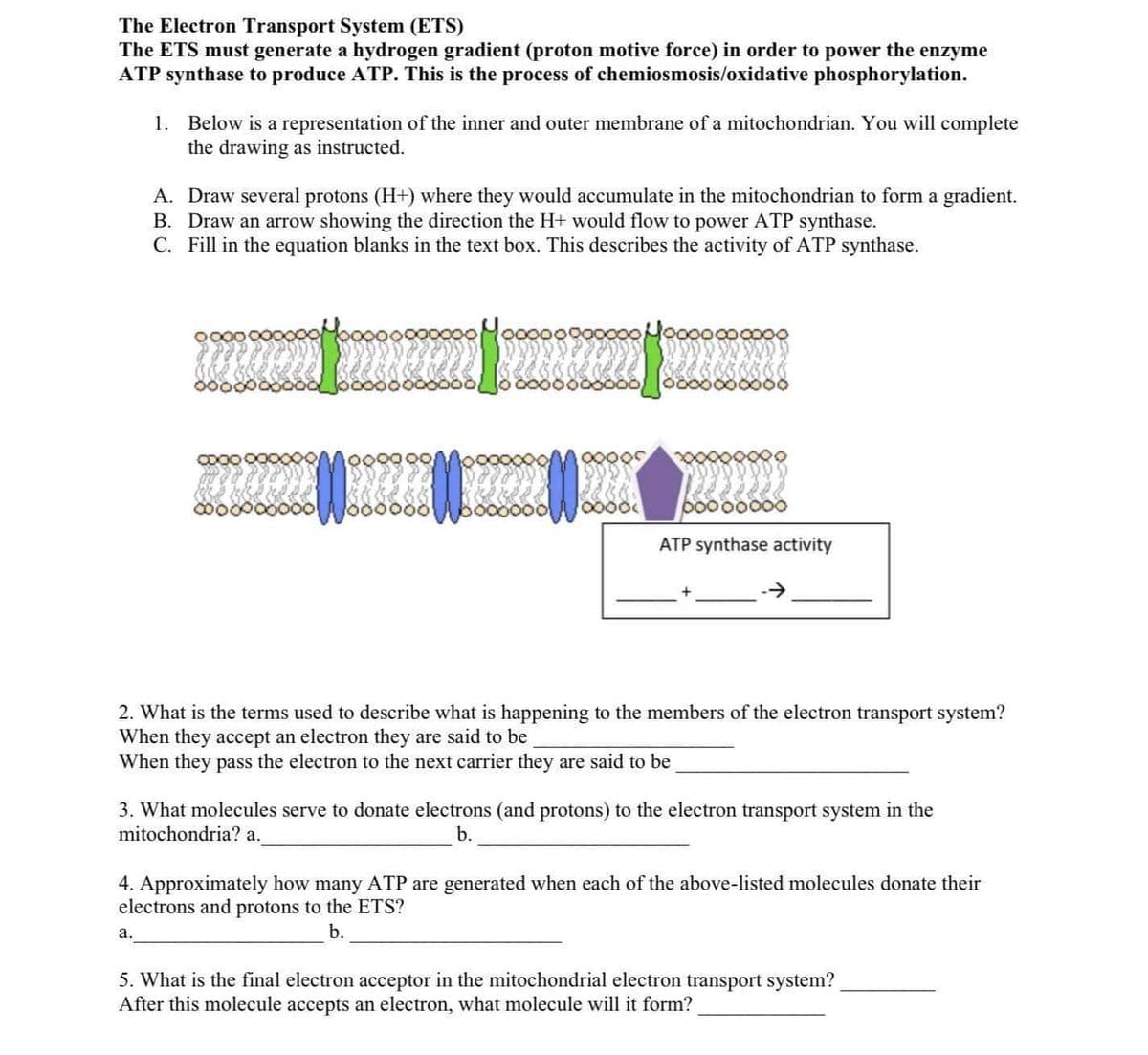2. What is the terms used to describe what is happening to the members of the electron transport system? When they accept an electron they are said to be When they pass the electron to the next carrier they are said to be 3. What molecules serve to donate electrons (and protons) to the electron transport system in the mitochondria? a. b. 4. Approximately how many ATP are generated when each of the above-listed molecules donate their electrons and protons to the ETS? b. a. 5. What is the final electron acceptor in the mitochondrial electron transport system? After this molecule accepts an electron, what molecule will it form?
2. What is the terms used to describe what is happening to the members of the electron transport system? When they accept an electron they are said to be When they pass the electron to the next carrier they are said to be 3. What molecules serve to donate electrons (and protons) to the electron transport system in the mitochondria? a. b. 4. Approximately how many ATP are generated when each of the above-listed molecules donate their electrons and protons to the ETS? b. a. 5. What is the final electron acceptor in the mitochondrial electron transport system? After this molecule accepts an electron, what molecule will it form?
Human Physiology: From Cells to Systems (MindTap Course List)
9th Edition
ISBN:9781285866932
Author:Lauralee Sherwood
Publisher:Lauralee Sherwood
Chapter2: Cell Physiology
Section: Chapter Questions
Problem 2TAHL
Related questions
Question
100%
answer 2,3,4,5

Transcribed Image Text:The Electron Transport System (ETS)
The ETS must generate a hydrogen gradient (proton motive force) in order to power the enzyme
ATP synthase to produce ATP. This is the process of chemiosmosis/oxidative phosphorylation.
1. Below is a representation of the inner and outer membrane of a mitochondrian. You will complete
the drawing as instructed.
A. Draw several protons (H+) where they would accumulate in the mitochondrian to form a gradient.
B. Draw an arrow showing the direction the H+ would flow to power ATP synthase.
C. Fill in the equation blanks in the text box. This describes the activity of ATP synthase.
00000
a.
ODOO 000
0000000000
000 00
0000001
oooooo
10 0000000000
00000
000
oooo
oooooooo
ATP synthase activity
2. What is the terms used to describe what is happening to the members of the electron transport system?
When they accept an electron they are said to be
When they pass the electron to the next carrier they are said to be
3. What molecules serve to donate electrons (and protons) to the electron transport system in the
mitochondria? a.
b.
4. Approximately how many ATP are generated when each of the above-listed molecules donate their
electrons and protons to the ETS?
b.
5. What is the final electron acceptor in the mitochondrial electron transport system?
After this molecule accepts an electron, what molecule will it form?
Expert Solution
This question has been solved!
Explore an expertly crafted, step-by-step solution for a thorough understanding of key concepts.
Step by step
Solved in 2 steps

Recommended textbooks for you

Human Physiology: From Cells to Systems (MindTap …
Biology
ISBN:
9781285866932
Author:
Lauralee Sherwood
Publisher:
Cengage Learning

Biology: The Unity and Diversity of Life (MindTap…
Biology
ISBN:
9781337408332
Author:
Cecie Starr, Ralph Taggart, Christine Evers, Lisa Starr
Publisher:
Cengage Learning

Biology Today and Tomorrow without Physiology (Mi…
Biology
ISBN:
9781305117396
Author:
Cecie Starr, Christine Evers, Lisa Starr
Publisher:
Cengage Learning

Human Physiology: From Cells to Systems (MindTap …
Biology
ISBN:
9781285866932
Author:
Lauralee Sherwood
Publisher:
Cengage Learning

Biology: The Unity and Diversity of Life (MindTap…
Biology
ISBN:
9781337408332
Author:
Cecie Starr, Ralph Taggart, Christine Evers, Lisa Starr
Publisher:
Cengage Learning

Biology Today and Tomorrow without Physiology (Mi…
Biology
ISBN:
9781305117396
Author:
Cecie Starr, Christine Evers, Lisa Starr
Publisher:
Cengage Learning